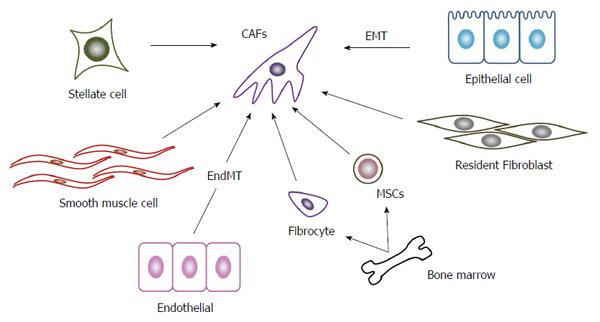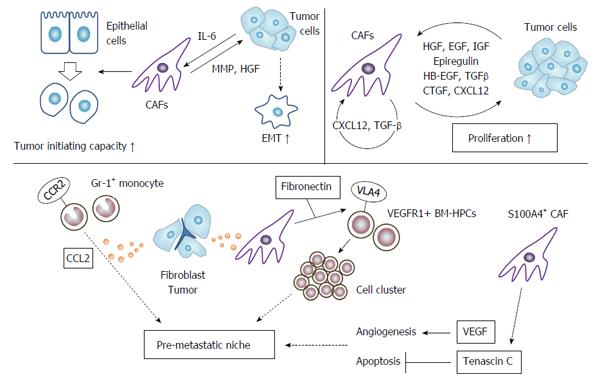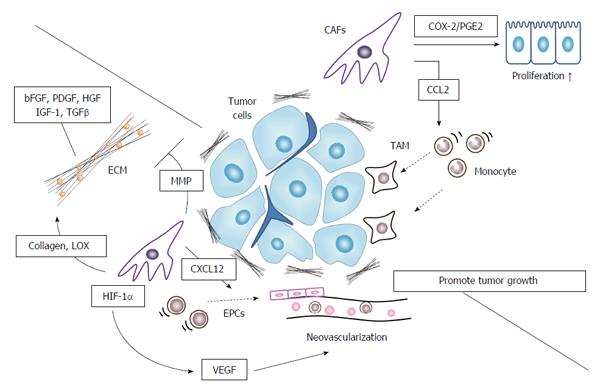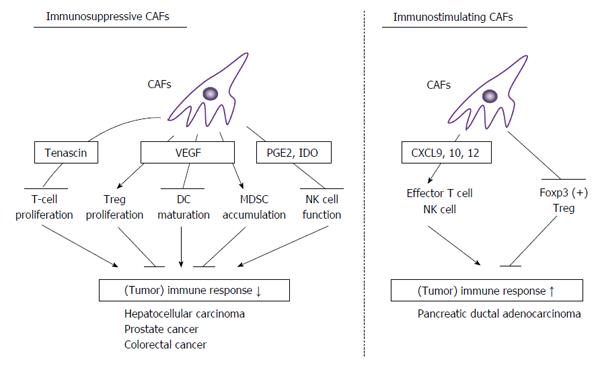Copyright
©The Author(s) 2016.
World J Gastroenterol. Jun 21, 2016; 22(23): 5301-5316
Published online Jun 21, 2016. doi: 10.3748/wjg.v22.i23.5301
Published online Jun 21, 2016. doi: 10.3748/wjg.v22.i23.5301
Figure 1 Origin of cancer associated fibroblasts.
A variety of cells can generate to CAFs. The most important cellular source of CAFs in CRC is presumed to be resident fibroblasts. Stellate cells in intestine may be able to transform into CAFs similarly as stellate cells in liver and pancreas do. Other potential sources include epithelial cells undergoing EMT, endothelial cells undergoing EndMT, smooth muscle cells, and bone marrow-derived cells including fibrocytes and MSCs. CAFs: Cancer associated fibroblasts; CRC: Colorectal cancer; EMT: Epithelial-mesenchymal transition; EdnMT: Endothelial-mesenchymal transition; MSCs: Mesenchymal stem cells.
Figure 2 Action of cancer associated fibroblasts on tumor cells.
CAF can induce tumor cells to enhance their tumor initiating capacity (stemness), and to undergo EMT. CAFs provide tumor cells with various growth factors to promote their growth. CAFs can also instigate pro-metastatic niche by inducing tumor cell cluster and angiogenesis, and suppressing tumor cell apoptosis. CAFs: Cancer associated fibroblasts; EMT: Epithelial-mesenchymal transition; VEGF: Vascular endothelial growth factor.
Figure 3 Cancer associated fibroblasts in tumor microenvironment formation.
CAFs promote pro-tumorigenic microenvironment by producing extracellular matrix to provide tumor cells with a growth advantage, recruiting tumor-associated macrophages (TAMs) to foster tumor cell growth, and inducing neovascularization. CAFs: Cancer associated fibroblasts; EMT: Epithelial-mesenchymal transition; VEGF: Vascular endothelial growth factor; ECM: Extracellular matrix proteins; EPCs: Endothelial progenitor cells; MMP: Matrix metalloproteinase; HIF-1α: Hypoxia-inducible factor 1α.
Figure 4 Double-edged actions of cancer associated fibroblasts in tumor immunity.
CAFs exhibit double-edged actions in tumor immunity. In most types of cancers, CAFs can dampen tumor immunity by suppressing T cell proliferation, NK cell activity, and DC maturation, and inducing Treg proliferation and MDSC accumulation. In some types of cancers such as pancreatic ductal adenocarcinoma, CAFs can enhance tumor immunity by enhancing effector T cell and NK cell functions and depressing Treg activities. CAFs: Cancer associated fibroblasts; VEGF: Vascular endothelial growth factor; MDSC: Myeloid-derived suppressor cells; NK: Natural killer.
- Citation: Mukaida N, Sasaki S. Fibroblasts, an inconspicuous but essential player in colon cancer development and progression. World J Gastroenterol 2016; 22(23): 5301-5316
- URL: https://www.wjgnet.com/1007-9327/full/v22/i23/5301.htm
- DOI: https://dx.doi.org/10.3748/wjg.v22.i23.5301
















